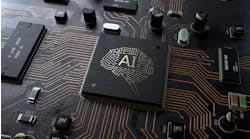Manufacturers are expected to face economic uncertainty in 2024, with the ongoing shortage of skilled labor, lingering supply chain disruptions, and new challenges spurred by the need for product innovation to meet company-set net-zero emissions goals. While generative AI holds promise to address these challenges, many manufacturers are struggling to discern hype from reality.
Having spent the last 25 years working with some of the largest discrete manufacturing companies to dramatically improve their data operations and machine learning analytics capabilities, I was thrilled to join industrial Software-as-a-Service (SaaS) provider Cognite to help manufacturers solve their data problems head-on.
See also: AI adoption crawling among manufacturers, new report finds
For the past year, much of my time has been spent talking directly to operators or manufacturers about how generative AI can and should be incorporated into their digital transformation strategies to realize benefits like better compliance, time saved, and improved collaboration. Here is what I’ve learned about the benefits of prioritizing data governance to thrive in the age of Gen-AI and drive positive business outcomes.
Liberating industrial data
To truly solve the industrial data and AI problem, we must make data accessible. This involves understanding data siloes, or why data is separated in the first place and how best to store, combine, and search different industrial data types efficiently. Rather than dissolving data siloes with a data lake, we form meaningful connections between them in an industrial knowledge graph, letting users quickly access various data types and making it easier to understand complex data.
See also: Powering cognitive digital threads with Gen-AI to accelerate innovation
Data users still spend up to 80% of their time searching, gathering, and cleaning data, costing businesses millions of dollars in working hours every year. This bottleneck toward productivity only will become worse in legacy architectures as IDC predicts data generation in asset-heavy organizations to increase by three times in the next two to three years. Industrial organizations must liberate all data across numerous siloed data sources, and then get the right data to the right subject matter experts (SMEs), with the right context, and at the right time.
Data’s value depends on trust
Data contextualization also raises the question of trust. Industrial enterprises must trust the data they put into solutions, from dashboards to digital twins to Gen-AI-powered solutions. Ultimately, data has value only if the business trusts and uses it.
See also: Process shortcomings a high hurdle for phasing in AI, survey finds
Organizations can increase trust and avoid other disadvantages of data lakes by adopting an industrial DataOps mindset. Such a mindset focuses on breaking down silos and optimizing the broad availability and usability of industrial data generated in asset-heavy industries including oil and gas and manufacturing. This approach makes data more valuable to a growing audience of data consumers, both inside the enterprise and across its partner ecosystem.
SMEs, for example, must be empowered to access and harness data effectively. With simple access to complex industrial data, industrial organizations can bring together formerly isolated SMEs, departments, platforms, and data deployed by OT and IT teams to improve operational performance through unified goals and KPIs across the enterprise.
Industrial data in a modern, open workspace
For every one person who can “speak code,” there are hundreds who cannot.
Users deserve a new way to interact with industrial data, one that delivers an ultimate no-code experience within a free-form workspace to derive cross-data-source insights and drive high-quality production optimization, maintenance, safety, and sustainability decisions.
See also: With Industrial Copilot, Siemens and Schaeffler help make Gen-AI ‘industrial grade’
With an intuitive, user-centric tool revolutionizing data exploration and visualization, SMEs and operators should be able to make cross-data source insights available without relying on data scientists, data engineers, and software engineers to build tailored case solutions. As a result, this enables users at every level of the organization to spend less time searching for and aggregating data and more time making high-quality business decisions.
With an industrial knowledge graph making data available in an open workspace, users can view all data types in one place, including documents, engineering diagrams, sensor data, images, 3D models, and more—data that matters to industrial end users, including process engineers, maintenance planners, reliability engineers, machine operators, technicians, and others.
However, a knowledge graph, which turns raw data into valuable operational insights, is only as powerful as the data it can access. To be effective in complex industrial settings, a knowledge graph allows users to:
- Go from search to discovery: When there are hundreds of data sources and countless name conventions, searching can be tedious. Discovering related data instantly will help you leap from antagonizing searches to discovering insights.
- Understand relationships, not just tables: The relationships often matter more to the answers we seek than the data entries they connect. Understanding our processes and systems requires understanding a company’s data real estate in its context.
- Execute industrial AI initiatives: Knowledge graphs help operationalize your data science, AI, machine learning, and Internet of Things (IoT) initiatives.
Properly assessing industrial DataOps software requires an understanding of two components: the foundation and connectivity.
Assessing the foundation is critical to ensure that the proposed solution will support your industrial data use cases and provide the tools needed to minimize time to value, scalability, and repeatability.
Connectivity has two components: data extraction and application layer. Data extraction will ensure that you will be able to connect to both existing and future data sources, while the application layer focuses on how the solution provider will support applications on top of the foundation to deliver use cases.
SMEs deserve to work with their industrial data in a collaborative environment where they can share workspaces, tag other users, and share insights as comments. This approach overcomes the single pane of glass solution, which often over-promises as a framework.
See also: AI is taking KPIs to the next level for the factory floor
Plus, this approach is often difficult to collaborate with and too rigid, preventing users from working with the data how they choose. Users can generate documents and diagram summaries, perform no-code calculations on time series data, and conduct root cause analysis of equipment with the guidance of the copilot.
Real-world examples of AI in action in industry
Every user can benefit from contextualized industrial data—from a rich, intuitive data exploration for SMEs, production managers, business analysts, and engineers to a "data-as-code" experience for data scientists who prefer SDK experiences. Creating an industrial knowledge graph by contextualizing data is a new way of serving all data consumers—data and analytics professionals and SMEs, business, and engineering professionals—with the same "real-time contextualized data at your fingertips" experience.
Let's look at other examples of AI applications for industry:
- Problem: Domain experts don't have a deep understanding of their data models and how to query across data types. Solution: A natural language as an alternative to traditional search, wherein the expert can Interact with a copilot to refine a search and get clear feedback to find the data they need quickly.
- Problem: Field workers need to understand equipment specs buried in huge documents. Solution: A copilot that summarizes the document's relevant paragraph(s), along with links to document locations.
- Problem: Developing industrial applications is time-consuming and costly. It's challenging to get the right data streams that provide the right insights to end users in a scalable way. Solution: Prompt engineering, or using NLP to discover inputs that yield the most desirable results, to replace many software applications and bypass the traditional app development cycles.
- Problem: Industrial companies must comply with numerous standards to ensure regulatory compliance and manage operational risks, requiring significant resources and coordination of siloed knowledge. Solution: Copilot for simplifying the compliance process for industrial companies through Gen-AI and vectorization.
- Problem: Rust can corrode and degrade equipment, machinery, and pipelines, leading to reduced functionality, decreased performance, and, in severe cases, complete failure. Solution: Generative AI-powered autonomous operations incorporating robotic inspection rounds with computer vision and GPT-4 analysis for early rust detection and automated work order generation.
From digital maturity to industrial transformation
There is no shortage of data in any industrial company, but there is a general lack of understanding on how to extract it, bring it together, and use it in a valuable way.
Industrial DataOps platforms are crucial to helping data workers deploy automated workflows to extract, ingest, and integrate data from industrial data sources, including legacy operations equipment and technology.
See also: Security implications of hastily implemented AI
It offers a workbench for data quality, transformation, and enrichment, as well as intelligent tools to apply industry knowledge, hierarchies, and interdependencies to contextualize and model data.
Overall, Gen-AI is changing how data consumers interact with data, but it must first be made available through specific application services for humans, machines, and systems to leverage.



